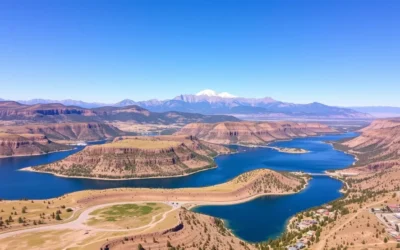Welcome to your ultimate guide to exploring one of Utah’s most spectacular natural wonders.
With over 2,000 natural stone arches, this remarkable national park draws visitors from around the world. Its stunning red rock landscapes and unique geological formations make it a must-visit destination for outdoor enthusiasts.
Discover the top attractions and activities that make this park a bucket-list destination, from iconic landmarks to scenic drives and hiking trails suitable for all ability levels.
Discovering the Wonders of Arches National Park
The rugged beauty of Arches National Park in Utah is a testament to the power of geological forces that have shaped the landscape over millions of years. As you explore this natural wonder, you’ll discover a landscape unlike anywhere else on Earth, featuring over 2,000 natural arches, hoodoos, fins of sandstone rocks, massive mesas, and balanced rocks.
The Geological Marvel of Over 2,000 Natural Arches
Arches National Park is renowned for its extraordinary concentration of natural stone arches. The park’s unique geological history has led to the formation of these remarkable structures through a combination of the right rock type, water erosion, and natural forces. Over time, the forces of erosion have sculpted the sandstone into the arches you see today.
The process of forming these arches is a complex one, involving the erosion of rock layers. The rock formations in the park have been shaped by millions of years of geological activity, resulting in the breathtaking landscape you witness today.
What Makes Arches National Park Unique
What sets Arches National Park apart from other national parks in Utah’s “Mighty 5” is its distinctive landscape, which has become an iconic symbol of the American Southwest. The park’s relatively compact size belies its diverse scenery and accessible natural wonders, making it an ideal destination for visitors of all ages and abilities.
The park offers a range of experiences, from short hiking trails to scenic drives. The diversity of the landscape, with its arches and other geological formations, ensures that Arches National Park is a must-visit destination for anyone interested in exploring the natural beauty of the Colorado Plateau.
Planning Your Visit to Arches National Park
Before you head out to explore Arches National Park, it’s crucial to plan your visit. Proper planning ensures that you make the most of your time and enjoy the park’s breathtaking landscapes without any hassles.
Best Time to Visit Arches National Park
Understanding the seasonal variations at Arches National Park is key to a successful visit. Spring and fall are the best seasons to visit, offering pleasant temperatures and moderate crowds. Summer can be extremely hot, but it provides longer daylight hours. Winter visits offer solitude but may come with snow, making some trails inaccessible. Visiting during the early morning or late afternoon is recommended for better photography lighting and fewer crowds.
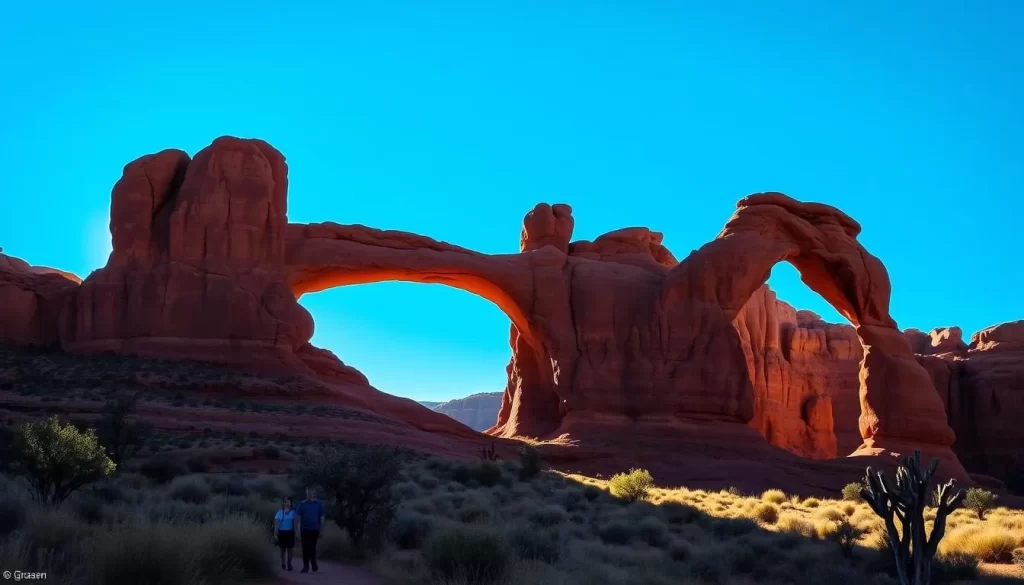
Timed Entry Permits: What You Need to Know
To manage the number of visitors, Arches National Park requires a timed entry permit from April 1 through July 6 and August 28 through October 31. These permits are released six months in advance, so it’s essential to plan ahead. You can obtain your permit through the official park website or recreation.gov. This system helps in distributing the visitor load, ensuring a more enjoyable experience for everyone.
Park Fees and Passes
The entrance fee for Arches National Park is $30 per vehicle, valid for seven consecutive days. Alternatively, you can opt for the America the Beautiful Pass for $80, which grants access to all national parks for a year. If you’re planning to visit other nearby parks like Canyonlands and Natural Bridges, consider the Southeast Utah Parks Pass for $55. These passes are not only cost-effective but also convenient for frequent visitors.
By understanding the best times to visit, the necessity of timed entry permits, and the available pass options, you can plan a memorable and stress-free trip to Arches National Park.
Driving the Scenic Arches Drive
Embark on the Scenic Arches Drive to discover the breathtaking views of Arches National Park. This scenic route is the backbone of your Arches National Park adventure, allowing you to explore the park’s main attractions at your own pace.
Route Overview and Key Stops
The Scenic Arches Drive is an 18-mile road that connects the park’s main areas, stretching to 22 miles if you include the two side roads. This paved road is typically open year-round, offering numerous viewpoints and access to some of the park’s most beautiful arches. Many of the park’s landmarks are just a short walk from the main road, making it easy to explore the park’s highlights.
- Experience the full beauty of Arches National Park by driving the 19-mile Scenic Drive, which serves as the park’s main artery, connecting all major viewpoints and trailheads.
- Enjoy the convenience of exploring many of the park’s highlights directly from the main road, with numerous pullouts offering spectacular views and short walks to impressive formations.
Tips for Navigating the Park by Car
To make the most of your driving tour, plan strategically by allowing at least half a day to cover the entire scenic route with stops at key viewpoints. Consider starting at the back of the park, near Devils Garden, in the morning to avoid crowds. It’s also wise to download or print a map beforehand, as cell service is limited throughout the park.
- Navigate the park efficiently by being prepared for limited parking at popular trailheads during peak hours.
- Consider enhancing your driving experience with a self-guided audio tour that provides fascinating information about the landscapes and formations you’ll encounter.
By following these tips, you can ensure a smooth and enjoyable drive through Arches National Park, taking in the stunning scenery and making the most of your visit.
Must-See Landmarks in Arches National Park
Among the many natural arches and rock formations, a few stand out as absolute must-sees in Arches National Park. These landmarks not only showcase the park’s unique geological features but also offer unforgettable experiences for visitors.
Delicate Arch: Utah’s Iconic Symbol
Delicate Arch is the most famous arch in Arches National Park and stands as an iconic symbol of Utah. Standing 52 feet tall with a 46-foot light opening, this free-standing arch is the largest in the park and frames the La Sal Mountains in the distance. You can marvel at Delicate Arch, taking in its grandeur and the unique landscape it frames.

Balanced Rock: A Gravity-Defying Wonder
Balanced Rock is another must-see landmark that is a popular stop along Arches Scenic Drive. This unique rock formation appears to defy gravity, with a 3,600-ton boulder perched precariously atop a narrow pedestal. It’s one of the park’s most photographed landmarks, and for good reason – it’s a gravity-defying wonder that sparks the imagination.
The Windows Section and Double Arch
The Windows Section is a concentrated area featuring massive arches, including North Window, South Window, and Turret Arch. These are accessible via short, interconnected trails that offer spectacular views. Just a short distance from the Windows Section is Double Arch, one of the park’s most impressive arches that doesn’t require a strenuous hike to visit. You can walk underneath Double Arch and even climb partway up for different perspectives.
| Landmark | Description | Accessibility |
|---|---|---|
| Delicate Arch | Utah’s iconic symbol, 52 feet tall | Hike required |
| Balanced Rock | Gravity-defying rock formation | Easily accessible from Arches Scenic Drive |
| Double Arch | Two massive arches sharing a foundation | 0.3 miles from Windows Section parking |
| The Windows Section | Concentrated area of massive arches | Short trails from parking area |
These landmarks are not only breathtaking but also represent the most impressive and accessible examples of Arches National Park’s unique geology. As you explore these must-see attractions, you’ll gain a deeper understanding of why they are so significant to the park’s natural beauty.
Arches National Park, Utah: Best Things to Do – Top Picks
The rugged beauty of Arches National Park beckons adventurers and nature lovers alike to explore its vast expanse. With over 2,000 natural arches and numerous hiking trails, the park offers a wide range of activities for visitors to enjoy.
Hiking to Delicate Arch
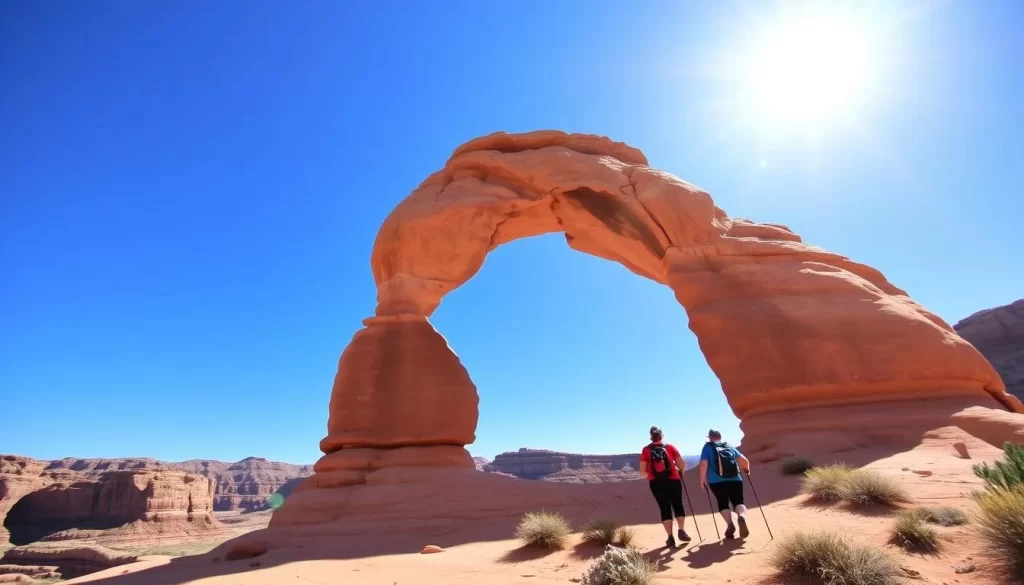
To get an up-close view of Delicate Arch, you’ll need to hike the 3-mile round trip trail, which takes you over slickrock and sandy trails. The trail is moderately difficult, with an uphill climb most of the way. While kids can manage this hike, it’s essential to keep a close eye on them, especially near the short section with a drop-off just before reaching the arch.
Prepare for your hike by bringing adequate water (at least one gallon per person in summer), sun protection, and sturdy footwear.
Exploring Devils Garden Trail
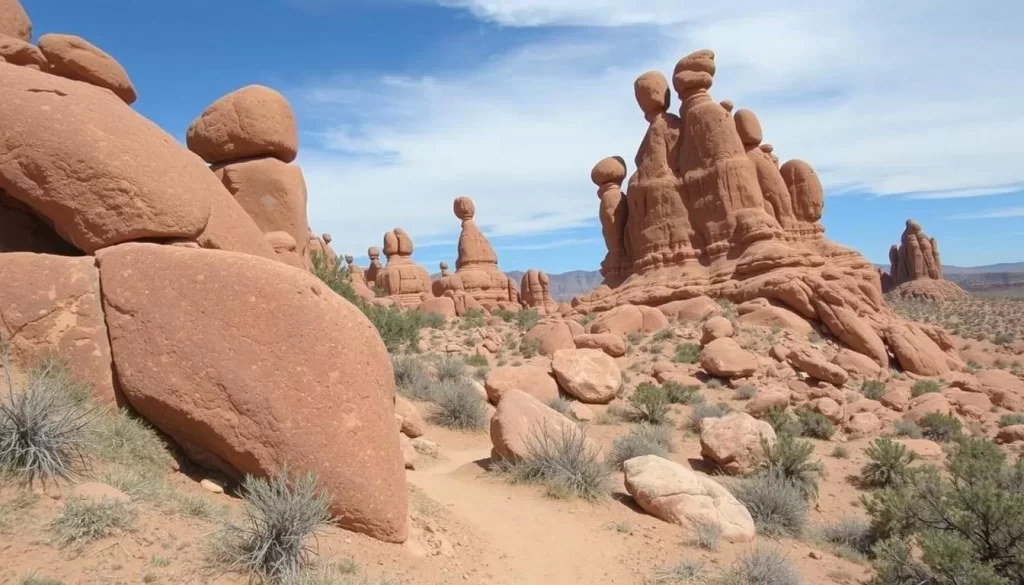
The Devils Garden Trail offers something for every hiker, from the relatively easy 1.6-mile round trip to Landscape Arch to the more challenging 7.2-mile primitive loop that showcases multiple impressive arches. This trail is a must-visit for anyone looking to experience the park’s unique geological formations.
Timing your visit strategically, such as early morning, can help you avoid crowds and enjoy more comfortable temperatures.
Photographing Landscape Arch
Landscape Arch, spanning 306 feet and thinning to just 6 feet in thickness at its center, is a photographer’s dream. Capture the perfect shot by visiting early in the morning or late in the afternoon when the light is soft and golden.
Tips for photography include using a tripod for stability and shooting during the golden hour for the best results.
Some of the top things to do in Arches National Park include:
– Embarking on the iconic 3-mile round trip hike to Delicate Arch
– Navigating the Devils Garden Trail, which offers options for hikers of all abilities
– Capturing the perfect photograph of Landscape Arch
– Timing your visits strategically to avoid crowds and enjoy comfortable temperatures
– Preparing properly for hikes with adequate water, sun protection, and sturdy footwear
Easy Hikes in Arches National Park
If you’re visiting Arches National Park with family or have mobility concerns, you’ll be pleased to know that there are numerous easy hikes to enjoy. These trails are designed to be accessible, allowing you to experience the park’s natural beauty without exerting too much effort.
Double Arch Trail (0.5 miles)
The Double Arch Trail is a short, 0.5-mile round trip walk that leads to one of the park’s most impressive arch formations. You can climb around the base of the double arch, making it a fun experience for families. This trail is well-maintained and takes about 30 minutes to complete, making it a great option for those with limited time.
Sand Dune and Broken Arch Loop (1.8 miles)
For a slightly longer hike, the Sand Dune and Broken Arch Loop is 1.8 miles and takes you through a shaded area between sandstone fins to Sand Dune Arch. The trail continues to the impressive Broken Arch, offering a more secluded experience. This hike is a great way to enjoy the park’s unique landscape while staying cool during the hot summer months.
Balanced Rock Loop (0.3 miles)
The Balanced Rock Loop is a short, 0.3-mile paved loop trail that provides 360-degree views of the iconic Balanced Rock. This trail is quick, taking just 15 minutes to complete, but it offers a memorable experience. You’ll be able to appreciate the gravity-defying nature of this natural wonder.
These easy hikes in Arches National Park are perfect for visitors of all ages and abilities. They allow you to enjoy the park’s beauty without the need for strenuous hiking. Whether you’re visiting in the morning or late afternoon, these trails are a great way to experience the park.
Moderate Hikes Worth Your Time
For those looking to step up their hiking experience, Arches National Park offers a range of moderate trails that balance accessibility with adventure. These hikes provide a great way to explore the park’s diverse landscapes and formations.
Park Avenue Trail (2 miles round trip)
The Park Avenue Trail is a 2-mile round trip hike that takes you through a stunning canyon flanked by massive rock formations, including the Three Gossips and Courthouse Towers. Although there are no arches on this trail, the scenery is breathtaking. The trail is best done as a point-to-point hike, but if you don’t have a second vehicle to shuttle, you can complete it as a round trip. The hike typically takes 30 to 45 minutes to complete.
The Windows Loop and Turret Arch (1 mile)
The Windows Loop Trail is a 0.7-mile round trip hike that connects three impressive arches: North Window, South Window, and Turret Arch. To see Turret Arch, take a short spur trail. This hike is relatively quick, taking about 30 to 45 minutes. The trail offers a great opportunity to see multiple arches in a short time.
Skyline Arch and Sand Dune Arch
For a varied hiking experience, combine visits to Skyline Arch and Sand Dune Arch. Skyline Arch is known for its dramatic views, especially after a large chunk fell off in 1940. Sand Dune Arch provides a cool, shaded sanctuary between towering rock fins. These hikes are part of the moderate trails that require a bit more time and effort but reward you with less crowded experiences and more dramatic perspectives of the park’s diverse formations.
These moderate hikes in Arches National Park offer a perfect balance of accessibility and adventure, making them ideal for those who want to explore beyond the easy trails. With hiking trails that range in difficulty and scenery, you’re sure to find a hike that suits your interests and abilities.
Devils Garden: The Ultimate Hiking Experience
Devils Garden stands out as one of the most spectacular hiking destinations in Arches National Park, boasting an array of trails for every kind of adventurer. This unique area is renowned for its concentration of natural arches and distinctive sandstone formations.
Landscape Arch to Double O Arch
The trail to Landscape Arch is a relatively easy 1.6-mile round trip, making it accessible to hikers of various skill levels. Along the way, you’ll pass by Pine Tree Arch and Tunnel Arch. For those seeking a more challenging hike, continuing beyond Landscape Arch leads to Double O Arch, a 4.2-mile round trip. The trail becomes more rugged, following narrow sandstone fins with breathtaking views.
The journey to Double O Arch is rewarding, with the arch featuring two distinct openings stacked on top of each other. This challenging section of the hike is sure to test your resolve but offers unparalleled views of the surrounding landscape.
The Primitive Loop for Adventure Seekers
For experienced hikers, the Primitive Loop offers a 2.1-mile challenging route that requires basic route-finding skills. This loop takes you across slickrock, through sandy washes, and over uneven terrain, marked by cairns. The Primitive Loop provides a unique perspective on Devils Garden, with opportunities to see Private Arch and enjoy solitude away from the more crowded trails.
| Trail | Distance (Round Trip) | Difficulty |
|---|---|---|
| Landscape Arch | 1.6 miles | Easy |
| Double O Arch | 4.2 miles | Moderate to Challenging |
| Primitive Loop | 2.1 miles (additional) | Challenging |
Devils Garden is a must-visit destination for anyone looking to experience the best of Arches National Park. With its diverse trails and breathtaking landscapes, it offers something for every hiker.
Best Photography Spots in Arches National Park
The ever-changing light and unique geological features of Arches National Park create a photographer’s dream landscape. As you plan your visit, understanding the best times and locations for photography will help you capture the park’s breathtaking beauty.
Sunrise Photography Locations
For sunrise photography, head to locations that benefit from the early morning light. Turret Arch, Double Arch, Landscape Arch, and the Three Gossips are ideal spots where the first rays of sun illuminate the eastern faces of these formations. The photo opportunities are vast, with the gentle morning light enhancing the textures and colors of the red rock landscapes.
Capture the morning essence at these places by arriving early and being prepared for the changing light conditions.
Sunset and Night Photography Opportunities
As the day progresses, sunset becomes another prime opportunity for photography. Delicate Arch, Balanced Rock, and the Fiery Furnace Viewpoint are among the top recommendations. The low-angle golden light during sunset brings out rich red and orange tones in the sandstone, making for stunning images.
After sunset, Arches National Park transforms into a photographer’s paradise for night photography. The park’s designation as one of the darkest places in the United States allows for exceptional captures of star trails, the Milky Way, and light-painted arches against the night sky. Take advantage of the clear skies and time your shots to capture the beauty of the night sky.

Off-the-Beaten-Path Experiences
Beyond the crowds, Arches National Park reveals its lesser-known treasures that promise adventure and solitude. For those willing to explore, the park offers unique experiences that are off the typical tourist trail.
Fiery Furnace: A Natural Labyrinth
The Fiery Furnace is one of the most unique places to visit in Arches National Park. It’s a natural labyrinth of impressive sandstone rock formations that can be viewed from the Fiery Furnace Viewpoint along the road. To truly experience its beauty, consider taking a guided tour with a park ranger or obtaining a backcountry permit to navigate its maze-like interior.
Visiting the Fiery Furnace at sunset is particularly breathtaking, as the setting sun lights up the sandstone rocks, coloring them bright orange. This area is a must-see for those looking for an adventure beyond the usual park attractions.

Tower Arch and Klondike Bluffs
Tower Arch, located in the remote Klondike Bluffs area, is another off-the-beaten-path destination worth exploring. It involves a 2.5-mile moderate round-trip hike from the Klondike Bluffs trailhead. For those with a 4×4 vehicle, it’s possible to drive closer to the arch, reducing the hike to 0.3 miles.
This secluded arch offers a unique perspective on the park’s natural beauty, with fewer visitors than the more accessible areas. The experience is enhanced by the surrounding landscape, making it a photographer’s delight.
These off-the-beaten-path experiences in Arches National Park not only provide solitude but also a deeper connection with the park’s wilderness. By venturing into areas like the Fiery Furnace and Tower Arch, visitors can experience the park in a new and exciting way.
Guided Tours and 4×4 Adventures

Explore the uncharted territories of Arches National Park with a guided 4×4 adventure that reveals its hidden gems. These tours offer a unique experience that allows you to venture beyond the paved roads and into the park’s more remote areas.
Half-Day Off-Road Experiences
Choose from half-day off-road adventures that focus exclusively on Arches’ backcountry. You’ll visit secluded arches, ancient petroglyphs, and dramatic viewpoints while learning about the area’s geology and history from knowledgeable local guides. This tour is an excellent way to see the park’s lesser-known areas in a short amount of time.
Combination Tours with Canyonlands
Maximize your time in the region with combination tours that explore both Arches and nearby Canyonlands National Park in a single day. This efficient way to experience the highlights of both parks is ideal for those with limited time. You’ll get to see the best of both worlds on this comprehensive trip.
By joining a guided 4×4 tour, you’ll benefit from the expertise of professional guides who know how to navigate the challenging terrain safely while sharing insights about the natural and cultural history. Consider these guided tours as complementary to your independent exploration of Arches’ main attractions.
Stargazing in Arches National Park
As the sun dips below the horizon, Arches National Park transforms into a stargazer’s paradise. The night sky over the park is one of the darkest in the United States, offering an unobstructed view of the stars. With minimal light pollution, you can witness the Milky Way in all its glory, making it an ideal destination for stargazing enthusiasts.
Best Locations for Night Sky Viewing
The park offers several prime stargazing locations. The Windows Section, Garden of Eden Viewpoint, and Balanced Rock are among the top spots. These locations not only provide dramatic foreground elements for photography but also offer open views of the celestial display. Plan your stargazing adventure around the lunar calendar to make the most of your visit.
During new moon periods, the skies are at their darkest, providing the best conditions for viewing the night sky. The Milky Way is particularly visible during summer months, arching dramatically overhead.
Tips for Stargazing Photography
To capture the beauty of the night sky, you’ll need to master some basic photography techniques. Use a sturdy tripod and a remote shutter release to minimize camera shake. A wide-angle lens and long exposures will help you capture both the stars and the silhouetted rock formations. Don’t forget to bring warm clothing, as desert temperatures drop significantly after sunset.
Additionally, using red-light headlamps will help preserve your night vision, and having sufficient water and snacks will ensure you’re comfortable during your stargazing session.
Essential Tips for Visiting Arches National Park
To ensure a memorable visit to Arches National Park, it’s crucial to be well-prepared. Planning ahead will not only enhance your experience but also help you navigate the challenges of exploring one of Utah’s most stunning national parks.
What to Pack for Your Visit
Packing the right gear is essential for a comfortable and enjoyable visit to Arches National Park. Make sure to bring plenty of water – at least one gallon per person per day during the summer months. Don’t forget sun protection, including a hat, sunglasses, and sunscreen, as well as sturdy footwear for hiking. Layers of clothing will help you adjust to temperature changes, and a printed map is a good idea since cell service can be unreliable.
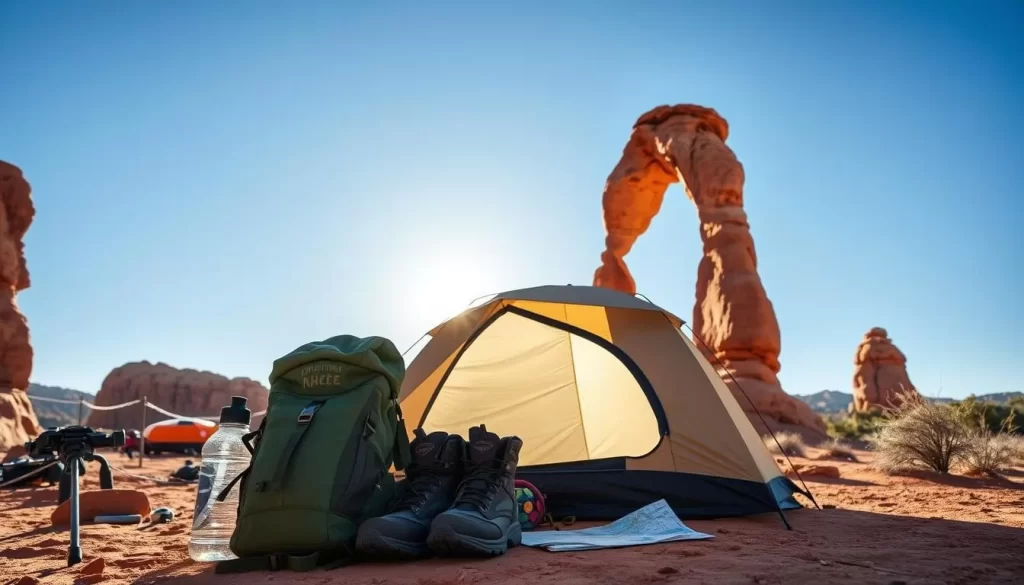
Staying Hydrated and Safe in the Desert
Staying hydrated is critical when visiting Arches National Park, especially during the hot summer months. Drink water consistently throughout your visit, and seek shade during the midday hours when the sun is strongest. Be aware of the early signs of heat exhaustion and plan your strenuous activities for the cooler morning or evening hours. Refill your water bottles at the visitor center, campground, or Devils Garden trailhead.
| Hydration Tips | Benefits |
|---|---|
| Drink at least 1 gallon of water per day | Prevents dehydration |
| Seek shade during midday | Reduces risk of heat exhaustion |
| Refill water bottles at designated points | Ensures continuous hydration |
Avoiding Crowds at Popular Spots
Visiting Arches National Park during the shoulder seasons (April-May and September-October) can help you avoid the crowds that flock to the park during the summer. Arriving early in the morning or later in the afternoon can also make a big difference. Stay flexible with your plans, and be prepared to adjust your itinerary if you encounter crowds at popular spots.
- Visit during shoulder seasons
- Arrive early or late in the day
- Stay flexible with your plans
One-Day and Multi-Day Itineraries
When planning your trip to Arches National Park, making the most of your time is crucial. The park offers a variety of experiences that can be tailored to fit your schedule, whether you’re visiting for a day or multiple days.
Perfect One-Day Itinerary
For a one-day visit, start early (before 8 am) at Devils Garden to hike to Landscape Arch before the crowds and heat intensify. Then, work your way back toward the entrance with stops at the Windows Section, Balanced Rock, and end with a sunset hike to Delicate Arch. This itinerary allows you to see the park’s highlights while minimizing driving time.
Two to Three Day Exploration Plan
With two or three days, you can explore Arches National Park at a more relaxed pace. Consider dedicating a day to hiking the Devils Garden primitive loop and other challenging trails. Another day can be spent on photography at optimal times, capturing the park’s breathtaking landscapes. On your third day, explore off-the-beaten-path areas like Tower Arch or take a guided 4×4 tour. You can also use Moab as your base to visit nearby attractions like Canyonlands National Park and Dead Horse Point State Park.
| Day | Activities |
|---|---|
| 1 | Hike to Landscape Arch, visit Windows Section, Balanced Rock, and Delicate Arch |
| 2 | Hike Devils Garden primitive loop, photography at optimal times |
| 3 | Explore Tower Arch, guided 4×4 tour, visit Canyonlands National Park |
Conclusion: Making the Most of Your Arches Adventure
As you conclude your journey through Arches National Park, reflect on the breathtaking natural wonders that make this destination truly unique. With over 2,000 natural stone arches, this national park is a testament to the awe-inspiring beauty of geological formations.
Your adventure in Arches National Park will be filled with unforgettable experiences. Whether you’re hiking to Delicate Arch, exploring the Devils Garden, or stargazing under the night sky, there’s something for everyone in this incredible park. Remember that flexibility is key to enjoying your visit, as weather conditions, crowd levels, and timed entry requirements may necessitate adjustments to your plans.
The different seasons transform Arches National Park, offering distinct experiences whether you visit during the vibrant colors of spring, the star-filled summer nights, the pleasant temperatures of fall, or the solitude and potential snow-dusted arches of winter. Appreciate how this national park caters to all, from accessible viewpoints perfect for families and those with limited mobility to challenging backcountry adventures for experienced hikers.
As you leave Arches National Park, take with you not just photographs but memories of the remarkable geological story told by these fragile formations. Understand that the arches you’ve witnessed are temporary features in the grand geological timeline, constantly changing and eventually falling as part of nature’s ongoing process. Your visit to this incredible park will be an adventure you’ll always treasure.
The above is subject to change.
Check back often to TRAVEL.COM for the latest travel tips and deals.




